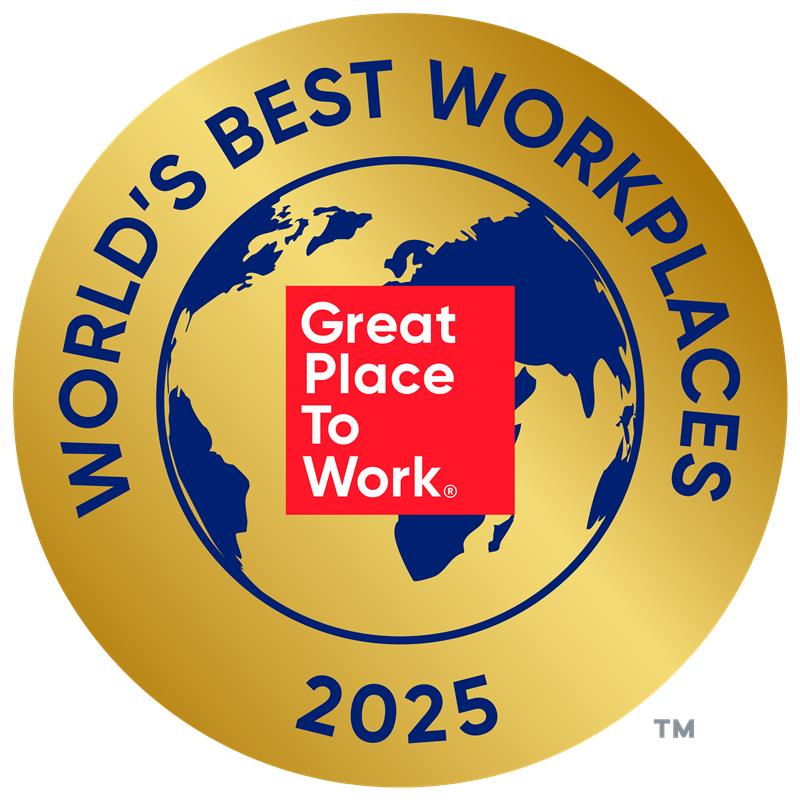
At Experian, we often say our people are our biggest superpower – and today, I’m thrilled to share that this belief has been recognised once again. Experian has been named one of the 2025 World’s Best Workplaces™ by Fortune and Great Place to Work® for the second year in a row.
This achievement reflects the culture we’ve built together – one that’s welcoming, inclusive, and rooted belonging. It’s a celebration of every colleague who brings their whole self to work, who lifts others up, and who powers opportunities for our clients, consumers, and communities.

We’ve made it our mission to create a workplace where everyone feels included, respected, and empowered. That’s why we’re proud to have earned top scores on the Corporate Equality Index and the Disability Equality Index, and to be recognised with the Outie Award for Workplace Excellence and Belonging.
These recognitions matter. But what matters most is how our people experience life at Experian. Whether it’s collaborating, innovating, or growing through world-class development of products, services and contributing to our communities, our culture is designed to help everyone thrive.
We’ve also made bold commitments to career development. Initiatives like Global Careers Week, the AI-driven performance coach Nadia, and the NextGen Forum – a global leadership development programme for emerging talent from across our regions – give our people the resources to take charge of their growth and build a “One Experian” mindset.
Being named one of the World’s Best Workplaces is a moment to celebrate but also a reminder to keep aiming higher. The world of work is evolving fast, and so are we. From embracing AI to enhancing our digital workplace experience, we’ll continue to push forward and listen to our people every step of the way.
Questions we will discuss:
- What does “retirement readiness” mean to you, and how can someone tell when they are financially ready to retire?
- Is there a magic number for retirement savings, and what factors should someone consider when setting a retirement goal?
- How can someone estimate their retirement expenses realistically?
- What are some common myths or misconceptions about how much money you need to retire?
- How should Gen Z, Millennials, and Gen Xers each approach retirement planning differently based on their stage of life?
- What are the biggest obstacles people face when trying to save for retirement, and how can they overcome them?
- How can you balance saving for retirement with paying off debt or supporting family today?
- What tools, calculators, or strategies can help people figure out if they’re on track for retirement?
- How can people prepare for unexpected costs or life changes that could impact their retirement plans?
- What’s one piece of advice you’d give someone just starting—or restarting—their retirement savings journey?
| Columns 1 | Column 2 | Column 3 | Column 4 |
|---|---|---|---|
| Row 1 Col 1 | |||
| Row 2 Col 1 | |||
| Row 3 Col 1 | |||
| Footer 1 | Footer 2 | Footer 3 | Footer 4 |

Credit Chat
Stretching your Dollars: Practical Tips to Cut Costs and Save More
February 5, 2025 3-4 PM ET
- What does “retirement readiness” mean to you, and how can someone tell when they are financially ready to retire?
- Is there a magic number for retirement savings, and what factors should someone consider when setting a retirement goal?
- How can someone estimate their retirement expenses realistically?

Greater transparency in buy now, pay later activity is key to helping consumers build their credit histories and supporting responsible lending. We have members of the military right now right out of high school and there’s not a lot of experience managing their own money. They’re quickly thrust into a place where they don’t have a support system to do that. We have members of the military right now right out of high school and there’s not a lot of experience managing their own money. They’re quickly thrust into a place where they don’t have a support system to do that. We have members of the military right now right out of high school and there’s not a lot of experience managing their own money. They’re quickly thrust into a place where they don’t have a support system to do that. We have members of the military right now right out of high school and there’s not a lot of experience managing their own money. They’re quickly thrust into a place where they don’t have a support system to do that. We have members of the military right now right out of high school and there’s not a lot of experience managing their own money. They’re quickly thrust into a place where they don’t have a support system to do that.
Experian North AmericaScott Brown, Group President, Financial Services

The first 24 hours of a Data Breach Response are the most critical and we have the most important seven steps to insure that your organization does not go off track. A data breach of personal identity information or protected healthcare information is a breach of trust. Employees, patients, consumers or even partners are put at risk if their information is disclosed during a security incident. In this session Experian’s data breach experts walked attendees through the first steps in the response process that will insure businesses do not run into trouble with the affected parties, the media and regulators. We included specific examples of what to do and how to be successful in your response. We touched on the key things to avoid, tapping over 10 years of experience and nearly 13,000 incidents serviced. For more information, visit www.experian.com/24hourchecklist. Vision 2014: The First 24 Hours of a Breach from Experian Business Information Services

The Small Business Credit Share is a “give-to-get” data consortium in which members provide more detailed data about the performance of the accounts in their portfolios. In exchange for expanded contribution, members get exclusive access to enriched information that is deeper in content than what is available to standard Experian clients or through competitive credit share programs. They benefit from the more comprehensive reports, business credit scores, attributes, and reporting that are available. The Small Business Credit Share is open to all credit granting institutions, including financial institutions, companies that issue trade credit, telcos, utilities and others. The tradeline performance reporting from this broad swath of B2B companies helps drive the effectiveness of the products that are available to members. The Small Business Credit Share has firm qualification standards to insure consistent information and regular reporting guidelines are followed, to help protect the interests of all members. In the past two-plus years, there has been good growth in the member base of the Small Business Credit Share. While attracting new members from a variety of industries, there also continues to be growing interest from financial institutions who presently report to other data consortia about becoming Small Business Credit Share members. Experian is working with them to highlight the advantages of reporting to multiple reporting agencies. In addition to increasing the likelihood that their interests will be protected if their customer’s obligations are more widely reported, they also give themselves more flexibility to manage the expense side of their operations. And when (not ‘if’) regulatory bodies shift their focus to the small business arena, some lenders are envisioning that broader reporting could become the rule. For example, the SBA is requiring that all SBA-backed loans be reported to commercial bureaus; whether that means to all commercial bureaus or to simply at least one is unclear. But the SBA’s rationale is clear: they want credit histories established for these companies so that SBA-backing should not be needed in the future. There are some exciting new products in development for Small Business Credit Share participants. The first of these is the upcoming release of an additional set of attributes which have been developed based on consumer experience and which will add considerable insight for credit risk managers. To assess their information value, these attributes were overlaid into a proof-of-concept score. The resultant model showed a 22% lift in KS and a 29% increase the percent of ‘bads’ pushed into the bottom 10% of the score range. There is also an ongoing development effort to replace the current Small Business Credit Share acquisition score. The new score will clearly benefit from the availability of the new attributes, but will also benefit from being developed on a population booked over a 2-year span from a much more recent time period (Nov 2010 to Oct 2012). The new score will be a blended model, with a ‘commercial-only’ option for clients that do not want to consider any consumer data within the score. The model will also use bureau-leveled consumer attributes, which will allow the model to work not only with Experian consumer data, but with consumer data from Equifax and Trans Union as well. Vision 2014: A Current Look at Commercial Credit Consortium Data from Experian Business Information Services

Did you know that this week is National Small Business Week? It is a time dedicated entirely to acknowledging the positive impact small businesses have on our economy. So let’s take a moment to recognize the contributions that millions of entrepreneurs and small business owners have made to our local communities. Whether it’s creating jobs or providing our favorite products and services at convenient locations, here’s to Small Business – they are truly the backbone of our nation’s economy. So during National Small Business Week, we at Experian will be participating in several activities that help small businesses understand their credit and make better decisions that will enable them to achieve and maintain success. Below are some of this week’s activities as well as some resources available to small business owners everyday: EVENTS: Wednesday, May 14 • 12 p.m. eastern – We will present a free webinar with the National Federation of Independent Business, and explore some of the misunderstandings of business credit, provide advice on how to build business credit and explain how a positive credit profile can help your business grow • 3 p.m. Eastern – We will continue the discussion on business credit, as we host a tweet chat (#CreditChat) with several small business experts. You’ll be able to ask questions and read best practices on how you can make business credit work for you. RESOURCES: • For access to tools and resources to help your business grow, visit www.experian.com/small-business • To better understand and learn the benefits managing your business credit, visit www.businesscreditfacts.com • For instant access to business credit report and scores, visit www.smartbusinessreports.com At Experian, we understand that en route to bringing communities our favorite barbers, ice cream stores, book shops, etc., small businesses owners experience challenges along the way. Whether it’s obtaining the necessary capital to make payroll or order more inventory, these challenges can seem a bit overwhelming and intimidating, especially when trying to manage the day to day operations of the business. This is why Experian helps entrepreneurs and small business owners by providing the right tools, resources and expert advice to help grow their businesses and keep our economy strong!
2024 Best Place to Work for Disability Inclusion


